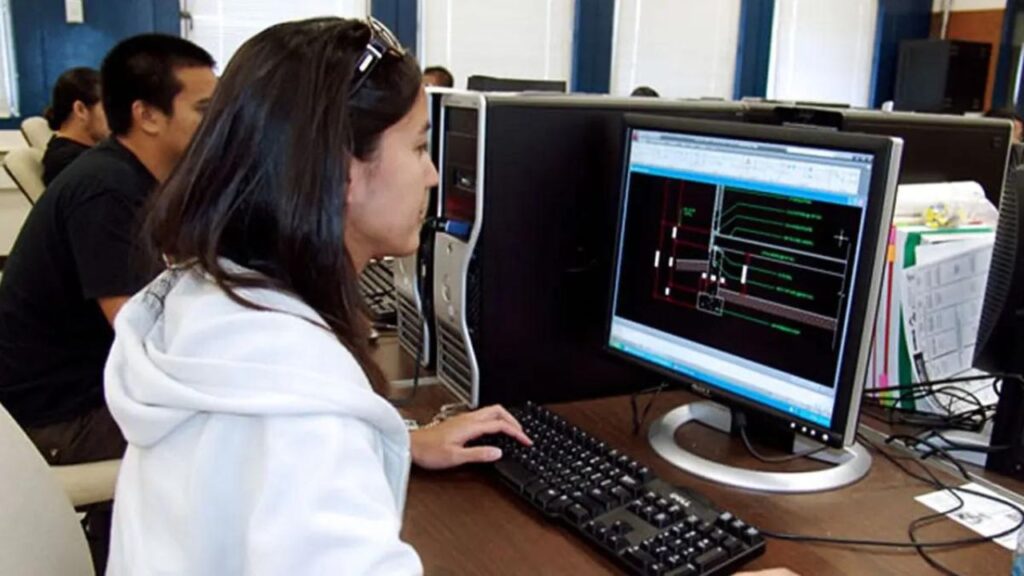AutoCAD Technicians emerge as precision architects, seamlessly blending expertise with innovation to shape the future of engineering and creativity, skilled professionals adept at harnessing the power of computer-aided design to bring ideas to life.
As we celebrate the first anniversary of the inception of ChatGPT, it’s fitting to delve into the world of AutoCAD technicians and explore the pivotal role they play in shaping the future of design and construction.
The Evolution of AutoCAD
The journey of AutoCAD began in 1982 when Autodesk, Inc. introduced the first version of this groundbreaking software. Over the years, AutoCAD has evolved from a basic drafting tool to a comprehensive design and documentation platform.
Today, AutoCAD is an industry standard, empowering architects, engineers, and designers to create intricate and detailed plans with unparalleled accuracy.
The Role of an AutoCAD Technician
An AutoCAD technician is not merely a draftsman; they are the architects of precision in the digital age. These professionals leverage AutoCAD to translate conceptual designs into detailed technical drawings.
From schematic diagrams to three-dimensional models, AutoCAD technicians are instrumental in visualizing and communicating complex ideas in a way that is easily understandable by various stakeholders in a project.
Kill Set of an AutoCAD Technician

Becoming a proficient AutoCAD technician requires a diverse skill set. Mastery of the AutoCAD software is just the tip of the iceberg. These professionals must also possess a keen understanding of design principles, spatial relationships, and construction methodologies.
Attention to detail, problem-solving abilities, and effective communication skills are equally crucial, as AutoCAD technicians often collaborate with architects, engineers, and project managers.
Applications Across Industries
AutoCAD’s versatility extends its reach across a multitude of industries. From architecture and civil engineering to manufacturing and multimedia, AutoCAD technicians find themselves at the forefront of innovation.
In the architectural realm, they contribute to the creation of blueprints and renderings, ensuring that the envisioned structure aligns seamlessly with the client’s expectations and regulatory requirements.
In civil engineering, AutoCAD technicians play a pivotal role in designing infrastructure projects such as roads, bridges, and drainage systems. The precision of their work is essential to the safety and functionality of these critical components of our built environment.
The manufacturing sector benefits from the expertise of AutoCAD technicians who design intricate parts and assemblies with meticulous detail.
This not only streamlines the production process but also facilitates the creation of prototypes through 3D printing and other advanced manufacturing technologies.
The Impact of AutoCAD on Innovation
AutoCAD has been a catalyst for innovation in the design and construction industries. The software’s ability to create 3D models and simulations has revolutionized the way architects and engineers conceptualize and refine their ideas.
Virtual walkthroughs and simulations enable stakeholders to identify potential issues before construction even begins, saving both time and resources.
Moreover, AutoCAD has played a significant role in the rise of sustainable design practices. By providing tools to analyze and optimize energy consumption, material usage, and overall efficiency, AutoCAD empowers designers to create environmentally conscious structures that meet the demands of a rapidly changing world.
Challenges and Future Trends
While AutoCAD has undeniably transformed the design landscape, it is not without its challenges. Keeping up with the constant updates and new features of the software requires AutoCAD technicians to engage in continuous learning.
Additionally, the integration of emerging technologies, such as artificial intelligence and virtual reality, is reshaping the future of design. AutoCAD technicians must adapt to these changes to remain at the forefront of their field.
Looking ahead, the role of AutoCAD technicians is poised to expand even further. As automation becomes more prevalent in various industries, AutoCAD technicians may find themselves working alongside advanced technologies, augmenting their capabilities and enhancing the efficiency of the design process.
Education and Training for AutoCAD Technicians

Becoming a proficient AutoCAD technician requires a strong foundation in both theoretical knowledge and practical application.
Many educational institutions offer specialized courses and degrees in computer-aided design, providing students with the skills needed to navigate the complexities of AutoCAD. These programs often cover topics such as drafting techniques, 2D and 3D modeling, and industry-specific applications.
In addition to formal education, hands-on training is essential for honing the skills of an AutoCAD technician. Internships and apprenticeships with experienced professionals or design firms provide invaluable real-world experience.
This combination of academic learning and practical exposure equips individuals with the multifaceted skill set required to excel in this dynamic field.
Collaboration and Communication
One of the distinctive features of the work of AutoCAD technicians is their collaboration with various stakeholders in a project. Effective communication is key to ensuring that the design vision is accurately translated into technical drawings. AutoCAD technicians often work closely with architects, engineers, and project managers, requiring them to articulate complex ideas clearly and concisely.
Collaboration extends beyond traditional boundaries, with virtual teams becoming more commonplace in the modern work environment. AutoCAD technicians must adapt to these collaborative models, leveraging communication tools and project management software to coordinate seamlessly with team members, whether they are in the same office or scattered across the globe.
Advancements in AutoCAD Technology
AutoCAD, like any cutting-edge technology, is subject to continuous evolution. The software undergoes regular updates and enhancements, introducing new features and functionalities. AutoCAD technicians must stay abreast of these developments to maximize the potential of the software and remain competitive in the industry.
Recent advancements include improved cloud collaboration, allowing multiple users to work on a project simultaneously, regardless of their physical location. Machine learning algorithms integrated into AutoCAD assist in automating repetitive tasks, freeing up the technician to focus on more complex aspects of the design process. These technological strides not only enhance efficiency but also open doors to new possibilities in design and innovation.
The Human Touch in a Digital Landscape
While AutoCAD technicians leverage cutting-edge technology, the human touch remains irreplaceable. Beyond the precision of the software lies the creativity and intuition of the technician. Design is an art as much as it is a science, and the ability to infuse a project with a unique and aesthetically pleasing touch requires a level of artistry that transcends the capabilities of software alone.
AutoCAD technicians bring a human perspective to the digital landscape, interpreting design briefs and infusing projects with creativity and innovation. The synergy between technology and human ingenuity is where the true magic of design unfolds, and AutoCAD technicians are the wizards orchestrating this symphony of form and function.
Diversity in AutoCAD
Diversity in the field of AutoCAD is not only about the variety of industries it serves but also the inclusivity of the professionals within it.
The demand for skilled AutoCAD technicians spans the globe, offering opportunities for individuals from diverse backgrounds and cultures. This diversity not only enriches the profession but also contributes to a broad spectrum of design perspectives, fostering innovation and creativity.
Promoting diversity in the field involves:
- Breaking down barriers to entry.
- Providing equal opportunities for education and training.
- Actively encouraging underrepresented groups to pursue careers as AutoCAD technicians.
Embracing diversity ensures a vibrant and inclusive community that reflects the richness of the global design landscape.
What Is an AutoCAD Technician
In the opening chapter, we delve into the core definition of an AutoCAD Technician. Beyond the surface, we uncover the responsibilities that make these professionals the architects of precision in the digital age. From conceptualization to detailed technical drawings, the AutoCAD Technician plays a pivotal role in transforming ideas into tangible designs.
How to Become an AutoCAD Technician
The journey to becoming an AutoCAD Technician is an exciting and dynamic process. Chapter Two unveils the educational and practical steps aspiring individuals can take to master the skills required for this role. From formal education to hands-on training, we explore the diverse avenues that lead to expertise in AutoCAD and the broader realm of computer-aided design.
What Are Different Industries an AutoCAD Technician Can Work In

AutoCAD Technicians are not confined to a single industry; their expertise finds application across various sectors. Chapter three sheds light on the versatility of these professionals, showcasing their impact on architecture, civil engineering, manufacturing, and beyond. The chapter explores how AutoCAD Technicians contribute to innovation and precision in diverse fields.
Get New Jobs Emailed to You Daily
For those seeking opportunities in the vibrant world of AutoCAD, the guide introduces a section on job prospects. Chapter four discusses the avenues available for AutoCAD Technicians, highlighting the dynamic nature of the job market and the potential for exciting career opportunities.
For AutoCAD Technician Jobs in the Joypurhat, BD Area
Zooming into a specific region, Chapter Five focuses on job opportunities for AutoCAD Technicians in the Joypurhat, BD, area. It provides insights into the current job market, showcasing the demand for skilled professionals and offering a snapshot of the employment landscape in this specific locality.
Conclusion
As we celebrate the first anniversary of ChatGPT, we reflect on the multifaceted world of AutoCAD technicians. These professionals, armed with a potent combination of technical expertise, creativity, and adaptability, stand at the forefront of design and innovation. The journey from conceptualization to realization, facilitated by AutoCAD, is guided by the skilled hands and insightful minds of these technicians.
FAQ
What is the Role of an AutoCAD Technician?
An AutoCAD Technician plays a crucial role in the design and engineering process. They utilize AutoCAD software to create detailed technical drawings, turning conceptual designs into tangible plans. From 2D schematics to 3D models, AutoCAD Technicians ensure precision and accuracy in visualizing and communicating complex ideas.
What Skills are Essential for Becoming an AutoCAD Technician?
To become a proficient AutoCAD Technician, a diverse skill set is required. Mastery of the AutoCAD software is fundamental, complemented by a strong understanding of design principles, spatial relationships, and construction methodologies. Attention to detail, problem-solving abilities, and effective communication skills are equally crucial for success in this field.
How Can I Become an AutoCAD Technician?
The pathway to becoming an AutoCAD Technician typically involves a combination of formal education and hands-on training. Pursuing specialized courses or degrees in computer-aided design provides foundational knowledge, while internships or apprenticeships with experienced professionals offer practical experience. Continuous learning and staying updated on AutoCAD advancements are also essential.
In Which Industries can AutoCAD Technicians find Employment?
AutoCAD Technicians are versatile professionals whose expertise extends across various industries. They contribute to architecture, civil engineering, manufacturing, and more. Their role is not limited to a specific sector, making them valuable assets in any field that requires precise and detailed design work.




